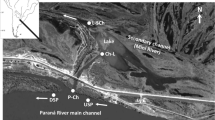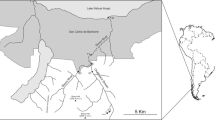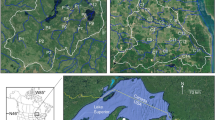Abstract
A method of rapidly assessing streams and rivers using chironomid pupal exuviae was tested on a chlordane-impacted stream near St. Louis, Missouri. Various concentrations of chlordane were found in sediments of Grand Glaize Creek, most likely resulting from soil runoff around housing and business developments throughout the stream's course. Chironomid pupal exuviae and sediment samples were collected concurrently from Grand Glaize Creek on two separate occasions, once in 1988 and again in 1990. Cluster analysis of samples at sites, based on the percent abundances of taxa within habitats and by subfamilies, produced two distinct clusters; one grouping samples with lower chlordane concentrations and the other grouping samples with higher chlordane concentrations. Further analysis showed a trend towards lower percent abundances of taxa living in depositional and transitional/depositional zones (Chironominae and some Tanypodinae) at the higher chlordane site, while the lower chlordane sites had lower percent abundances of taxa within erosional and erosional/transitional zones (Orthocladiinae and some Tanypodinae). These findings support the hypothesis that taxa living in close association to fine organic sediments will be exposed to higher concentrations of chlordane in the stream and more negatively affected than taxa feeding and living in habitats removed from chlordane-bound sediments. Comparisons from the present study were made to related studies revealing similar patterns among the Chironomidae.
Similar content being viewed by others
References
Armitage, P. D. & J. H. Blackburn, 1985. Chironomidae in a Pennine stream system receiving mine drainage and organic enrichment. Hydrobiologia 121: 165–172.
Ashe, P., D. A. Murray & F. Reiss, 1987. The zoological distribution of Chironomidae (Insecta: Diptera). Ann. Limnol. 23: 27–60.
Cardwell, R. D., D. G. Foreman, T. R. Payne & D. J. Wilbur, 1977. Acute and chronic toxicity of chlordane to fish and invertebrates. EPA 600/3–77–019. Office of Research and Development, US Environmental Protection Agency, Duluth, Minnesota.
Cavanaugh, W. J. & J. E. Tilden, 1930. Algal food, feeding and case-building habits of the larva of the midge fly, Tanytarsus dissimilis. Ecology 11: 281–287.
Clements, W. H., D. S. Cherry & J. Cairns, Jr., 1988. Impact of heavy metals on insect communities in streams: a comparison of observational and experimental results. Can. J. Fish. aquat. Sci. 45: 2017–2025.
Coffman, W. P., 1973. Energy flow in a woodland stream ecosystem: II. The taxonomic composition and phenology of the Chironomidae as determined by the collection of pupal exuviae. Arch. Hydrobiol. 71: 281–322.
Coffman, W. P. & L. C. Ferrington, Jr., 1984. Chironomidae. Chapter 25. In Merritt, R. W. & K. W. Cummins (eds), An Introduction to the Aquatic Insects of North America. Second Edition. Kendall/Hunt Publishing Co., Dubuque, 722 pp.
Coler, B. G., 1984. Community responses of Chironomidae (Diptera) to organic enrichment in a small Kansas stream. Master's thesis, University of Kansas, Lawrence, Kansas, 81 pp.
Cranston, P. S., D. R. Oliver & O. A. Saether, 1983. 9. The larvae of Orthocladiinae (Diptera: Chironomidae) of the Holarctic region — Keys and diagnoses. Ent. scand. Suppl. 19: 149–291.
Crunkilton, R. L., 1990. Bioavailability of technical chlordane to channel catfish (Ictalurus punctatus). Ph.D. dissertation. University of Missouri-Columbia, Columbia, Missouri, 295 pp.
Epler, J. H., 1988. Biosystematics of the genus Dicrotendipes Kieffer, 1913 (Diptera: Chironomidae: Chironominae) of the world. Mem. Am. Ento. Soc. 36: 1–214.
Ferrington, L. C., Jr., 1987. Collection and identification of surface-floating pupal exuviae of Chironomidae for use in studies of surface water quality. US EPA, Region VII, Kansas City, Kansas, Standard Operating Procedure No. FW 130A, 25 pp.
Ferrington, L. C., Jr. & N. H. Crisp, 1989. Water chemistry characteristics of receiving streams and the occurrence of Chironomus riparius and other Chironomidae in Kansas. Acta Biol. Debr. Oecol. Hung. 3: 115–126.
Ferrington, L. C., Jr. & F. J. Schmidt, 1986. Composition of Chironomidae in permanent and intermittent streams influenced by heavy metals in Cherokee County, Kansas. NABS Bulletin, published abstract.
Ferrington, L. C. Jr., M. A. Blackwood, C. A. Wright, N. H. Crisp, J. L. Kavanaugh & F. J. Schmidt, 1991. A protocol for using surface-floating pupal exuviae of Chironomidae for rapid bioassessment of changing water quality. In Sediment and Stream Water Quality in a Changing Environment: Trends and Explanation. Proceedings of the Vienna Symposium. IAHS Publ. no. 203: 181–190.
Ludemann, D. & H. Neumann, 1962. Über die Wirkung der neuzeitlichen Kontaktinsektizide auf die Tiere des Susswassers. Anz. Schaedhingskd Pifanzen-Umweltschutz 35: 5.
Maschwitz, D. E., 1975. Revision of the Nearctic species of the subgenus Polypedilum (Chironomidae: Diptera). Ph.D. thesis, University of Minnesota, 325 pp.
McGill, J. D., R. S. Wilson & A. M. Brake, 1979. The use of chironomid pupal exuviae in the surveillance of sewage pollution within a drainage system. Wat. Res. 13: 887–894.
Oliver, D. R., M. E. Dillon & P. S. Cranston, 1990. A catalog of Nearctic Chironomidae. Res. Br. Ag. Can. Publ. 1857/B, 89 pp.
Pinder, L. C. V., 1983. 1. The larvae of Chironomidae (Diptera) of the Holarctic region — Introduction. Ent. scand. Suppl. 19: 7–10.
Pinder, L. C. V. & F. Reiss, 1983. 10. The larvae of Chironominae (Diptera: Chironomidae) of the Holarctic region — Keys and diagnoses. Ent. scand. Suppl. 19: 293–435.
Ruse, L. P., 1985. Investigation of heavy metal impacts on rivers using chironomid pupal exuviae. Report of Cambridge Water Division. Anglian Water, England, 36 pp.
Ruse, L. P. & R. S. Wilson, 1984. The monitoring of river water quality within the Great Ouse Basin using the chironomid exuvial analysis technique. War. Pollut. Control 83: 116–135.
Schmidt, F. J., 1987. Biological monitoring of heavy metals pollution in streams of the Tri-State Mining District. Master's thesis, University of Kansas, Lawrence, Kansas, 88 pp.
Smock, L. A., 1983. The influence of feeding habits on whole-body metal concentrations in aquatic insects. Freshwat. Biol. 13: 301–311.
Timmermans, K. R. & C. Davids, 1988. Differences in trace metal concentration in chironomid larvae related to their feeding habit. Acta Biol. Debr. Oecol. Hung. 3: 361–376.
Timmermans, K. R., B. van Hattum, M. H. S. Kraak & C. Davids, 1989. Trace metals in a littoral foodweb: concentrations in organisms, sediment and water. Sci. Tot. Environ. 87/88: 477–494.
US Environmental Protection Agency, 1976. Pesticidal aspects of chlordane and heptachlor in relation to man and the environment — a further review, 1972–1975. EPA 540/4–76–005. Office of Pesticide Programs, Washington, D.C.
US Environmental Protection Agency, 1980. Ambient water quality criteria for chlordane. EPA 440/5–80–027. Office of Water Regulations and Standards, Washington, D.C.
van de Guchte, C. & C. J. van Leeuwen, 1988. Chapter 29. Sediment Pollution. In de Kruijf, H. A. M., D. de Zwart, P. N. Viswanathan & P. K. Ray (eds), Manual of Aquatic Ecotoxicology. Proceedings of the Indo-Dutch Training course on Aquatic Ecotoxicology. Kluwer Academic Publishers, Dordrecht, 332 pp.
Ward, J. H., 1963. Hierarchical grouping to optimize an objective function, J. Am. Statist. Assoc. 58: 236–244.
Wilson, R. S., 1988. A survey of the zinc-polluted River Nent (Cumbria) and the East and West Allen (Northumberland), England, using chironomid pupal exuviae. Spixiana. Suppl. 14: 167–174.
Wilson, R. S. & P. L. Bright, 1973. The use of chironomid pupal exuviae for characterizing streams. Freshwat. Biol. 3: 283–302.
Wilson, R. S. & J. D. McGill, 1977. A new method of monitoring water quality in a stream receiving sewage effluent, using chironomid pupal exuviae. Wat. Res. 11: 959–962.
Wilson, R. S. & S. E. Wilson, 1983. A reconnaissance of the River Rhine using Chironomidae pupal exuviae (Insecta: Diptera). Mem. Amer. Ent. Soc. 34: 361–385.
Winner, R. W., M. W. Boesel & M. P. Farrell, 1980. Insect community structure as an index of heavy-metal pollution in lotic systems. Can. J. Fish. aquat. Sci. 37: 647–655.
Wright, C. A., 1988. The utility of surface-floating Chironomidae pupal exuviae in assessing the impact of PCBs on two stream communities. National Network for Environmental Policy Studies Report. Activity Nos. ETR81 and ETR82, 42 pp.
Yasuno, M., S. Hatakeyama & Y. Sugaya, 1985. Characteristic distribution of chironomids in the rivers polluted with heavy metals. Verh. internat. Ver. Limnol. 22: 2371–2377.
Author information
Authors and Affiliations
Rights and permissions
About this article
Cite this article
Wright, C.A., Ferrington, L.C. & Crisp, N.H. Analysis of chlordane-impacted streams using chironomid pupal exuviae (Diptera: Chironomidae). Hydrobiologia 318, 69–77 (1996). https://doi.org/10.1007/BF00014133
Received:
Revised:
Accepted:
Issue Date:
DOI: https://doi.org/10.1007/BF00014133




